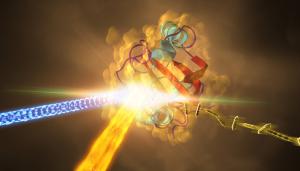LAB REPORT
Science and Technology Making Headlines
Dec. 12, 2014


The target for the National Ignition Facility is the size of a BB.
Lucky No. 13
The Laboratory achieved No. 13 in Discover Magazine’s top 100 stories of 2014.
Lab physicists pointed 192 lasers on a plastic sphere the size of a BB. Inside were ingredients for a powerful fusion reaction similar to the kind that makes our sun hot and glowing.
When they switched the lasers on, they found that more energy came out of the fuel than went in. The research, reported in February, is a crucial milestone toward tapping the power of lab-made fusion.


This artist’s rendering depicts an experiment that revealed how a protein from photosynthetic bacteria changes shape in response to light.
Tracking life’s chemistry
An international research team that includes researchers from Lawrence Livermore has captured the highest-resolution protein snapshots ever taken with an X-ray laser, revealing how a key protein in a photosynthetic bacterium changes shape when hit by light.
Human biology is a massive collection of chemical reactions and all involve proteins, known as the molecules of life. Scientists have been moving steadily toward their ultimate goal of following these life-essential reactions step by step in real time, at the scale of atoms and electrons.
The results show that the same method could be used with all kinds of biological molecules, including medically and pharmaceutically important proteins.
The results have implications for research on some of the most pressing challenges in life sciences, which include understanding biology at its smallest scale and discovering molecular targets for drug design.


Tiziana Bond, an LLNL engineer, helped develop a cost-effective and more efficient way to manufacture nanoporous metals.
Smaller than a pore
Lawrence Livermore and the Swiss Federal Institute of Technology researchers have developed a cost-effective and more efficient way to manufacture nanoporous metals over many scales, from nanoscale to macroscale, which is visible to the naked eye.
Nanoporous metals — foam-like materials that have some degree of air vacuum in their structure — have a wide range of applications because of their superior qualities.
They possess a high surface area for better electron transfer, which can lead to the improved performance of an electrode in an electric double capacitor or battery. Nanoporous metals offer an increased number of available sites for the adsorption of analytes, a highly desirable feature for sensors.


Sierra is the next in a long line of supercomputers at Lawrence Livermore National Laboratory.
This computer is faster than yours
The Energy Department recently signed a $450 million deal to build the fastest supercomputers in the world for its national laboratories in Livermore and Oak Ridge, and to aim for even faster computers in the future.
The powerful new machine at Lawrence Livermore National Laboratory, code-named Sierra, will be used primarily for the Lab’s “stockpile stewardship” program designed to assure the safety and reliability of the nation’s nuclear weapons without having to test them.
The computer also will be used for its multibillion-dollar National Ignition Facility, where scientists are seeking to achieve controlled thermonuclear fusion in the laboratory.


Mechanical engineer Reg Beer (right) and electronics engineer Gary Johnson test a new polymerase chain reaction (PCR) instrument developed at Lawrence Livermore that can process biological samples in less than three minutes.
Talk to the expert
Lab Manager recently interviewed Reginald Beer, a medical diagnostics initiative leader at Lawrence Livermore National Laboratory, to discuss his expertise in digital polymerase chain react (PCR) technology. PCR is a biomedical technology in molecular biology used to amplify a single copy or a few copies of a piece of DNA across several orders of magnitude, generating thousands to millions of copies of a particular DNA sequence.
While touting the advantages of digital PCR, Beer explains that not every lab needs to invest in this technology. Lab managers should look closely at their samples and assays to determine if digital PCR is needed for their application.
“The biggest advantage of digital PCR is that it offers an extremely accurate quantitation of the copy number [of the target molecule] in your sample,” Beer said. “The obvious limitation of partitioning your sample into different reactors is that you now have to observe and record tens of thousands, if not millions, of reactors instead of just a few cuvettes or samples.”





